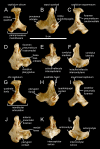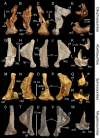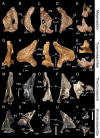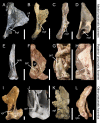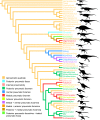The non-avian theropod quadrate I: standardized terminology with an overview of the anatomy and function - PubMed (original) (raw)
The non-avian theropod quadrate I: standardized terminology with an overview of the anatomy and function
Christophe Hendrickx et al. PeerJ. 2015.
Abstract
The quadrate of reptiles and most other tetrapods plays an important morphofunctional role by allowing the articulation of the mandible with the cranium. In Theropoda, the morphology of the quadrate is particularly complex and varies importantly among different clades of non-avian theropods, therefore conferring a strong taxonomic potential. Inconsistencies in the notation and terminology used in discussions of the theropod quadrate anatomy have been noticed, including at least one instance when no less than eight different terms were given to the same structure. A standardized list of terms and notations for each quadrate anatomical entity is proposed here, with the goal of facilitating future descriptions of this important cranial bone. In addition, an overview of the literature on quadrate function and pneumaticity in non-avian theropods is presented, along with a discussion of the inferences that could be made from this research. Specifically, the quadrate of the large majority of non-avian theropods is akinetic but the diagonally oriented intercondylar sulcus of the mandibular articulation allowed both rami of the mandible to move laterally when opening the mouth in many of theropods. Pneumaticity of the quadrate is also present in most averostran clades and the pneumatic chamber-invaded by the quadrate diverticulum of the mandibular arch pneumatic system-was connected to one or several pneumatic foramina on the medial, lateral, posterior, anterior or ventral sides of the quadrate.
Keywords: Anatomy; Dinosaur; Mandibular articulation; Quadrate; Terminology; Theropod.
Conflict of interest statement
The authors have declared that no competing interests exist.
Figures
Figure 1. Avian and non-avian theropod terminology of the quadrate bone.
Left quadrate of the common ostrich Struthio camelus (NH.11.75; courtesy of Paolo Viscardi) in (A, G) anterior, (B, H) lateral, (C, I) posterior, (D, J) medial, (E, K) dorsal, and (F, L) ventral views. The ostrich quadrate is annotated with (A–F) Baumel & Witmer (1993), Elzanowski, Paul & Stidham (2001) and Elzanowski & Stidham’s (2010) terminologies, and (G–L) the here proposed terminology for the non-avian theropod quadrate.
Figure 2. Anatomy of non-avian theropod quadrates.
Line drawings of the right (A–E) quadrate of Tsaagan mangas (IGM 100-1015) in (A) anterior, (B) lateral, (C) posterior, (D) medial and (E) ventral views; left (F–I) and right (J–K) quadrates (F) of Baryonyx walkeri (NHM R9951), (G) Aerosteon riocoloradensis (MCNA-PV-3137), (H) an indeterminate Oviraptoridae (IGM A; Maryańska & Osmólska, 1997), (I) Tyrannosaurus rex (BHI 3333; Larson & Carpenter, 2008), (J) Allosaurus ‘_jimmadseni_’ (SMA 0005), and (K) Majungasaurus crenatissimus (FMNH PR 2100) in (F–I) posterior and (J–K) ventral views. Abbreviations: ain, anterior intercondylar notch; dqjc, dorsal quadratojugal contact; ecc, ectocondyle; enc, entocondyle; ics, intercondylar sulcus; lpq, lateral process of the quadrate; mar, mandibular articulation; mfq, medial fossa of the quadrate; oca, otic capitulum; pfl, pterygoid flange; pfq, posterior fossa of the quadrate; pin, posterior intercondylar notch; ppf, posterior pneumatic foramen; qb, quadrate body; qf, quadrate foramen; qh, quadrate head; qj, quadratojugal; qjp, quadratojugal process; qr, quadrate ridge; qrg, quadrate ridge groove; qs, quadrate shaft; sqc, squamosal contact; sca, squamosal capitulum; vqjc, ventral quadratojugal contact; vpdq, ventral projection of the dorsal quadratojugal contact; vsh, ventral shelf.
Figure 3. Topological homologies in the non-averostran theropod quadrate.
Left (A, C, F) and right (B, D, E; reversed) quadrates of Dilophosaurus wetherilli (UCMP 37302) in (A) anterior, (B) lateral, (C) posterior, (D) medial, (E) dorsal and (F) ventral views (courtesy of Randall Irmis and Matthew Carrano). Right quadrate (G–L; reversed) of Majungasaurus crenatissimus (FMNH PR 2100) in (G) anterior, (H) lateral, (I) posterior, (J) medial, (K) dorsal, and (L) ventral views. Left quadrate (M–R) of Baryonyx walkeri (NHM R9951) in (M) anterior, (N) lateral, (O) posterior, (P) medial, (Q) dorsal, and (R) ventral views. Right quadrate (S–W) of Eustreptospondylus oxoniensis (OUMNH J.13558; reversed) in (S) anterior, (T) lateral, (U) posterior, (V) medial and (W) ventral views (courtesy of Paul Barrett). Abbreviations: afq, anterior fossa; ain, anterior intercondylar notch; dqjc, dorsal quadratojugal contact; ecc, ectocondyle; enc, entocondyle; ics, intercondylar sulcus; lpq, lateral process; mfq, medial fossa; pfq, posterior fossa; pfl, pterygoid flange; qf, quadrate foramen; qh, quadrate head; qjp, quadratojugal process; qr, quadrate ridge; vpdq, ventral projection of the dorsal quadratojugal contact; vqjc, ventral quadratojugal contact; vsh, ventral shelf of the pterygoid flange.
Figure 4. Topological homologies in the non-avian averostran quadrate.
Left quadrate (A–F) of Aerosteon riocoloradensis (MCNA-PV-3137) in (A) anterior, (B) lateral, (C) posterior, (D) medial, (E) dorsal, and (F) ventral views (courtesy of Martin Ezcurra). Left quadrate (G–K) of Alioramus altai (IGM 100-1844) in (G) anterior, (H) lateral, (I) posterior, (J) medial, and (K) dorsal views (courtesy of Mike Ellison © AMNH). Right quadrate (L) of Qianzhousaurus sinensis (GM F10004-1; reversed) in ventral views (courtesy of Stephen Brusatte). Right quadrate (M–Q) of Falcarius utahensis (UMNH VP 14559; reversed) in (M) anterior, (N) lateral, (O) posterior, (P) medial, and (Q) ventral views (courtesy of Lindsay Zanno). Left quadrate (R–W) of Bambiraptor feinbergi (AMNH 30556) in (R) anterior, (S) lateral, (T) posterior, (U) medial, (V) dorsal, and (W) ventral views. Abbreviations: afq, anterior fossa; dqjc, dorsal quadratojugal contact; ecc, ectocondyle; enc, entocondyle; ics, intercondylar sulcus; lpfo, lateral pneumatic fossa; lpq, lateral process; mfq, medial fossa; mpf, medial pneumatic foramen; pfq, posterior fossa; ppf, posterior pneumatic foramen; pfl, pterygoid flange; qf, quadrate foramen; qh, quadrate head; qjp, quadratojugal process; qr, quadrate ridge; vpdq, ventral projection of the dorsal quadratojugal contact; vpf, ventral pneumatic foramen; vqjc, ventral quadratojugal contact; vsh, ventral shelf of the pterygoid flange.
Figure 5. Morphology and position of pneumatic openings in the quadrate of non-avian Theropoda.
Right quadrate (A) of the carcharodontosaurid Acrocanthosaurus atokensis (NCSM 14345; reversed) in medial view. Left quadrate (B) of the carcharodontosaurid Mapusaurus roseae (MCF-PVPH-108) in medial view. Left quadrate (C) of the carcharodontosaurid Giganotosaurus carolinii (MUCPv CH 1) in medial view. Right quadrate (D) of the therizinosaur Falcarius utahensis (UMNH VP 14559; reversed) in medial view (courtesy of Lindsay Zanno). Right quadrate (E) of the metriacanthosaurid Sinraptor dongi (IVPP 10600; reversed) in posterior view (courtesy of Philip Currie). Left quadrate (F) of the neovenatorid Aerosteon riocoloradensis (MCNA PV 3137) in posterior view (courtesy of Martín Ezcurra). Left quadrate (G) of the ornithomimid Garudimimus brevipes (IGM 100–13) in posterior view (courtesy of Yoshitsugu Kobayashi). Right quadrate (H) of the dromaeosaurid Buitreraptor gonzalezorum (MPCA 245; reversed) in posterior view. Right quadrate (I) of the tyrannosaurid Alioramus altai (IGM 100–844) in ventral view (courtesy of Mick Ellison). Left quadrate (J) of the tyrannosaurid Tyrannosaurus rex (FMNH PR2081; cast, reversed) in ventral view. Left quadrate (K) of the carcharodontosaurid Mapusaurus roseae (MCF-PVPH-108) in anterior view. Left quadrate (L) of the neovenatorid Aerosteon riocoloradensis (MCNA PV 3137) in lateral view (courtesy of Martín Ezcurra). Abbreviations: apf, anterior pneumatic foramen; lpq, lateral process; lpfo, lateral pneumatic fossa; mpf, medial pneumatic foramen; ppf, posterior pneumatic foramen; ppfo, posterior pneumatic fossa; qf, quadrate foramen; vpf, ventral pneumatic foramen. Scale bars = 10 cm (A–C, J, K), 5 cm (E–G, L), 1 cm (D, H, I).
Figure 6. Distribution of quadrate pneumaticity in Theropoda.
Cladogram of non-avian theropods based on the theropod classification summarized by Hendrickx, Mateus & Araújo (2015) and showing the phylogenetic distribution of quadrate pneumaticity and the different quadrate pneumatic foramina in theropod dinosaurs. Silhouettes by Funkmonk (Dilophosaurus, Shuvuuia, Dromaeosauroides, and Suzhousaurus), M. Martyniuk (Ornitholestes and Similicaudipteryx), T. Michael Keesey (Deinocheirus), Choiniere et al. (; Zuolong; modified) and S. Hartman (all others).
Similar articles
- Morphofunctional Analysis of the Quadrate of Spinosauridae (Dinosauria: Theropoda) and the Presence of Spinosaurus and a Second Spinosaurine Taxon in the Cenomanian of North Africa.
Hendrickx C, Mateus O, Buffetaut E. Hendrickx C, et al. PLoS One. 2016 Jan 6;11(1):e0144695. doi: 10.1371/journal.pone.0144695. eCollection 2016. PLoS One. 2016. PMID: 26734729 Free PMC article. - Early development of the facial region in a non-avian theropod dinosaur.
Rauhut OW, Fechner R. Rauhut OW, et al. Proc Biol Sci. 2005 Jun 7;272(1568):1179-83. doi: 10.1098/rspb.2005.3071. Proc Biol Sci. 2005. PMID: 16024380 Free PMC article. - Air-filled postcranial bones in theropod dinosaurs: physiological implications and the 'reptile'-bird transition.
Benson RB, Butler RJ, Carrano MT, O'Connor PM. Benson RB, et al. Biol Rev Camb Philos Soc. 2012 Feb;87(1):168-93. doi: 10.1111/j.1469-185X.2011.00190.x. Epub 2011 Jul 7. Biol Rev Camb Philos Soc. 2012. PMID: 21733078 Review. - The theropod furcula.
Nesbitt SJ, Turner AH, Spaulding M, Conrad JL, Norell MA. Nesbitt SJ, et al. J Morphol. 2009 Jul;270(7):856-79. doi: 10.1002/jmor.10724. J Morphol. 2009. PMID: 19206153 Review.
Cited by
- Cranial functional specialisation for strength precedes morphological evolution in Oviraptorosauria.
Meade LE, Pittman M, Balanoff A, Lautenschlager S. Meade LE, et al. Commun Biol. 2024 Apr 10;7(1):436. doi: 10.1038/s42003-024-06137-1. Commun Biol. 2024. PMID: 38600295 Free PMC article. - Insight into the evolutionary assemblage of cranial kinesis from a Cretaceous bird.
Wang M, Stidham TA, O'Connor JK, Zhou Z. Wang M, et al. Elife. 2022 Dec 5;11:e81337. doi: 10.7554/eLife.81337. Elife. 2022. PMID: 36469022 Free PMC article. - The osteology and affinities of Eotyrannus lengi, a tyrannosauroid theropod from the Wealden Supergroup of southern England.
Naish D, Cau A. Naish D, et al. PeerJ. 2022 Jul 7;10:e12727. doi: 10.7717/peerj.12727. eCollection 2022. PeerJ. 2022. PMID: 35821895 Free PMC article. - The first edentulous ceratosaur from South America.
de Souza GA, Soares MB, Weinschütz LC, Wilner E, Lopes RT, de Araújo OMO, Kellner AWA. de Souza GA, et al. Sci Rep. 2021 Nov 18;11(1):22281. doi: 10.1038/s41598-021-01312-4. Sci Rep. 2021. PMID: 34795306 Free PMC article. - The evolutionary and functional implications of the unusual quadrate of Longipteryx chaoyangensis (Avialae: Enantiornithes) from the Cretaceous Jehol Biota of China.
Stidham TA, O'Connor JK. Stidham TA, et al. J Anat. 2021 Nov;239(5):1066-1074. doi: 10.1111/joa.13487. Epub 2021 Jun 16. J Anat. 2021. PMID: 34137030 Free PMC article.
References
- Bakker RT. Brontosaur killers: late Jurassic allosaurids as sabre-tooth cat analogues. Gaia. 1998;15:145–158.
- Balanoff AM, Norell MA. Osteology of Khaan mckennai (Oviraptorosauria: Theropoda) Bulletin of the American Museum of Natural History. 2012;372:1–77. doi: 10.1206/803.1. - DOI
- Balanoff AM, Xu X, Kobayashi Y, Matsufune Y, Norell MA. Cranial osteology of the theropod dinosaur Incisivosaurus gauthieri (Theropoda: Oviraptorosauria) American Museum Novitates. 2009;3651:1–35. doi: 10.1206/644.1. - DOI
- Barbosa A. Identification key of Iberian waders (Charadriiformes) based on the os quadratum. Miscellània Zoològica. 1990;14:181–185.
- Barsbold R. Kinetism and peculiarity of the jaw apparatus of oviraptors (Theropoda, Saurischia) Soviet-Mongolian Paleontological Expedition, Trudy. 1977;4:37–47. (in Russian)
Grants and funding
This research was supported by the Fundação para a Ciência e a Tecnologia (FCT) scholarships (Ministério da Ciência, Tecnologia e Ensino superior, Portugal) SFRH/BD/62979/2009 (CH) and SFRH/BPD/96205/2013 (RA). The funders had no role in study design, data collection and analysis, decision to publish, or preparation of the manuscript.
LinkOut - more resources
Full Text Sources
Other Literature Sources
